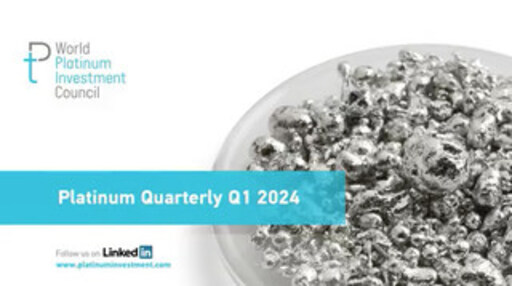LONDON, November 22, 2016 /PRNewswire/ --
- Stable automotive demand for platinum
- 2016 Chinese jewellery market softer than previously forecast
- 2017 forecast projects sixth consecutive annual market deficit
The World Platinum Investment Council (WPIC) today announces the publication of its latest Platinum Quarterly - the first independent, freely-available, quarterly analysis of the global platinum market. This report incorporates analysis of platinum supply and demand during the third quarter of 2016, accompanied by a forecast for the full year 2016 as well as an initial forecast for 2017. Today's report estimates that the deficit for the full year 2016 will be lower than previously forecast, as a result of softening of Chinese jewellery demand.
(Logo: http://photos.prnewswire.com/prnh/20160302/339553LOGO )
Platinum Quarterly is a WPIC publication. It is largely based upon research and detailed analysis commissioned with, and conducted by, SFA Oxford (SFA), an independent authority on the platinum group metals market.
Paul Wilson, chief executive officer of WPIC commented: "This edition of Platinum Quarterly forecasts a market that is set to remain in deficit in 2016 and 2017, marking the fifth and sixth consecutive years of deficits in the platinum market. The deficit for 2016 has been revised lower this quarter, reflecting a slowdown in retail jewellery sales in China, accentuated at the manufacturer level, due to higher than expected levels of retailer jewellery recycling this year. Chinese jewellery retailers are seeing reduced sales of gold products (due to anti-gifting legislation), which slowed footfall, thereby reducing overall Chinese platinum jewellery sales. However, we continue to see medium-term growth prospects in China as significant.
"It is interesting to note that one year on from the VW scandal, automotive demand for platinum remains relatively stable, with rising total vehicle sales set to offset a modest decrease in European diesel share this year. Media coverage in the last 12 months has caused some concern among consumers and investors as to the future of diesel. However, our forecasts firmly indicate that global automotive platinum demand will dip by just 1 per cent in 2017. Diesel cars can, and will, meet demanding real world driving standards on emissions. Consequently, new diesels will continue to play a critical role in helping automakers meet their CO2 emissions obligations."
Overview of key data presented in Platinum Quarterly:
SFA's revised supply and demand forecast has recast the full-year 2016 deficit, scaling it back by 350 koz, to a predicted deficit of 170 koz:
- Global demand in 2016 is forecast to decrease by 3 per cent year-on-year to 8,040 koz, while total platinum supply is expected to be marginally lower year-on-year at 7,870 koz.
- Total supply is set to be 35 koz lower year-on-year, as lower refined production in South Africa (-230 koz) outweighs an increase in jewellery recycling (+110 koz) related to weaker consumer offtake in China.
- Jewellery demand is projected to fall by 300 koz this year - down 10 per cent year-on-year - with growth in India, North America and Western Europe unable to offset lower manufacturer buying in China and Japan.
- Industrial demand in 2016 is expected to rise by 2 per cent year-on-year following stronger demand for use in chemical catalysis, petroleum refining and other industrial end-uses.
- Total investment demand for the year is forecast at 350 koz due to robust bar and coin demand and a modest decline in ETF holdings.
- The forecast market deficit of 170 koz in 2016 is expected to reduce estimated above ground stocks to 2,145 koz at the end of the year.
For the third quarter of 2016, today's report shows a fall in both supply and demand.
- Total global supply of platinum was down 9 per cent from Q2 2016 to 2,000 koz, with total mining supply estimated at 1,490 koz.
- Total global demand for platinum was 1,940 koz during the third quarter, down by 5 per cent from Q2 2016 and by 17 per cent year-on-year.
- Total mining supply in Q3 declined 235 koz quarter-on-quarter due to lower production from South Africa. This was driven by safety stoppages and producers replenishing inventories used during outages earlier in the year.
- Total recycling in Q3 increased 30 koz quarter-on-quarter to 510 koz, as higher jewellery recycling (+55 koz) from retailer destocking in China more than offset a decline in autocatalyst secondary supply (-25 koz).
- The main contributing factor to the decline in Q3 demand was seasonally lower autocatalyst demand, down 90 koz quarter-on-quarter. This was partly offset by the 45 koz increase in jewellery demand, which included a 20 per cent increase in India, following heavy promotion of men's platinum jewellery.
- Third quarter industrial demand decreased by 10 koz and investment demand was 50 koz lower this quarter as Japanese investors eased back on their platinum bar and coin purchases.
Today's report also includes a complete forecast for 2017, which estimates that the platinum market deficit will continue next year, marking the sixth consecutive year of market deficits.
- Total platinum supply in 2017 is forecast to fall 2% to 7,745 koz, with mining supply expected to be flat year-on-year in 2017 at 6,000 koz, and platinum recycling expected to decline to 1,745 koz (down 6 per cent year-on-year). Recycled platinum from autocatalysts is expected to stay relatively flat, while global jewellery recycling is projected to drop by 120 koz, as recycling in China returns to a more typical level.
- Total platinum demand in 2017 is also forecast to fall 2 per cent year-on-year to 7,845 koz with projected growth in jewellery demand unable to offset expected declines in automotive, industrial and investment demand.
- Automotive demand for platinum is expected to dip by 1 per cent to 3,360 koz in 2017, due to a slight decline in autocatalyst demand.
- Jewellery sales are expected to grow in 2017 by 2 per cent, supported by strong demand in India.
- Lower requirements for use in petroleum refining, chemical catalysis and glass fabrication are estimated to reduce industrial demand 6 per cent to 1,610 koz next year.
- Total investment demand is projected to be 250 koz next year due to healthy demand for bars and coins and a modest increase in ETF holdings.
To download this edition of Platinum Quarterly and/or subscribe to receive the research in the future, without charge, please visit our website: http://www.platinuminvestment.com
Notes to Editors:
About the World Platinum Investment Council
The World Platinum Investment Council Ltd. (WPIC) is a global market authority on physical platinum investment, formed to meet the growing investor demand for objective and reliable platinum market intelligence. WPIC's mission is to stimulate global investor demand for physical platinum through both actionable insights and targeted product development. WPIC was created in 2014 by the six leading platinum producers in South Africa: Anglo American Platinum Ltd, Aquarius Platinum Ltd, Impala Platinum Ltd, Lonmin plc, Northam Platinum Ltd and Royal Bafokeng Platinum Ltd.
For further information, please visit http://www.platinuminvestment.com.
WPIC's offices are located at: 64 St James's Street, London, SW1A 1NF.
About SFA (Oxford)
Founded in 2001, SFA (Oxford) is regarded as one of the most important independent authorities on the platinum group metals market. The company's in-depth market research and integrity is underpinned by extensive consulting from mine to market to recycler, as well as an unrivalled global industry network.
SFA have a team of nine dedicated PGM analysts with wide and varied industry expertise and knowledge, each one specialising in a core area of the value chain, as well as many internationally-based associates. SFA is able to provide its clients with answers to the most difficult questions affecting the future of the industry.
For more information go to: http://www.sfa-oxford.com
About Platinum
Platinum is one of the rarest metals in the world with distinctive qualities making it highly valued across a number of diverse demand segments. Platinum's unique physical and catalytic properties have established its value in industrial applications. At the same time, its unique precious metal attributes have made it the premier jewellery metal.
Platinum's supply comes from two main sources: primary mining output, and recycling, which typically comes from end of life auto catalysts and jewellery recycling. Over the last five years, between 72% and 77% of total annual platinum supply (in refined ounces) has come from primary mining output.
Global demand for platinum is strong and becoming more diverse. There are four core segments of platinum demand: automotive, industrial, jewellery and investment demand.
Platinum demand from autocatalysts has equated to between 37% and 42% of total demand in the last five years. Platinum's diverse other industrial uses account on average for a little over 20% of total global demand (five year average). Over the same period, global annual jewellery demand has averaged 34% of total platinum demand. Investment is the smallest category of platinum demand and also the most variable over the past five years, ranging between 2% and 11% of total demand (excluding movements in vaulted investor holdings).
For any media requests, please contact CNC Communications:
Claire Maloney or Simon Evans
T: +44(0)20-3219-8803 / +44(0)20-3219-8809
[email protected]
SOURCE World Platinum Investment Council (WPIC)
WANT YOUR COMPANY'S NEWS FEATURED ON PRNEWSWIRE.COM?
Newsrooms &
Influencers
Digital Media
Outlets
Journalists
Opted In





Share this article